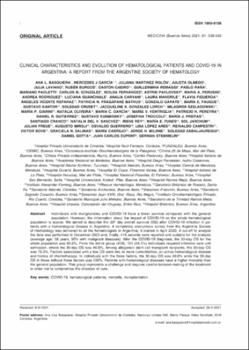Clinical characteristics and evolution of hematological patients and COVID-19 in Argentina: a report from the Argentine Society of Hematology

View/
Date
2021-05Author
Kusminsky, Gustavo.
Basquiera, Ana.
García, Mercedes.
Metadata
Show full item recordAbstract
Abstract in English, Spanish
Individuals with malignancies and COVID-19 have a lower survival compared with the general population. However, the information about the impact of COVID-19 on the whole hematological population is scarce. We aimed to describe the 30th day overall survival (OS) after COVID-19 infection in patients with a hematological disease in Argentina. A completely anonymous survey from the Argentine Society of Hematology was delivered to all the hematologists in Argentina; it started in April 2020. A cut-off to analyze the data was performed in December 2020 and, finally, 419 patients were reported and suitable for the analysis (average age: 58 years, 90% with malignant diseases). After the COVID-19 diagnosis, the 30-day OS for the whole population was 80.2%. From the entire group (419), 101 (24.1%) individuals required intensive care unit admission, where the 30-day OS was 46.6%. Among allogeneic stem cell transplant recipients, the 30-day OS was 70.3%. Factors associated with a low OS were two or more comorbidities, an active hematological disease and history of chemotherapy. In individuals with the three factors, the 30-day OS was 49.6% while the 30-day OS in those without those factors was 100%. Patients with hematological diseases have a higher mortality than the general population. This group represents a challenge and requires careful decision-making of the treatment in order not to compromise the chances of cure.
Keywords: COVID-19; hematological patients; mortality; transplantation.
Collections
The following license files are associated with this item:

